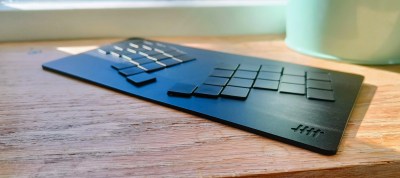The ARRL used to have a requirement that any antenna advertised in their publications had to have real-world measurements accompanying it, to back up any claims of extravagant performance. I’m told that nowadays they will accept computer simulations instead, but it remains true that knowing what your antenna does rather than just thinking you know what it does gives you an advantage. I was reminded of this by a recent write-up in which the performance of a mylar sheet as a ground plane was tested at full power with a field strength meter, because about a decade ago I set out to characterise an antenna using real-world measurements and readily available equipment. I was in a sense field testing it, so of course the first step of the process was to find a field. A real one, with cows. Continue reading “Field Testing An Antenna, Using A Field”
Slider4880 Articles
Big Chemistry: Fuel Ethanol
If legend is to be believed, three disparate social forces in early 20th-century America – the temperance movement, the rise of car culture, and the Scots-Irish culture of the South – collided with unexpected results. The temperance movement managed to get Prohibition written into the Constitution, which rankled the rebellious spirit of the descendants of the Scots-Irish who settled the South. In response, some of them took to the backwoods with stills and sacks of corn, creating moonshine by the barrel for personal use and profit. And to avoid the consequences of this, they used their mechanical ingenuity to modify their Fords, Chevrolets, and Dodges to provide the speed needed to outrun the law.
Though that story may be somewhat apocryphal, at least one of those threads is still woven into the American story. The moonshiner’s hotrod morphed into NASCAR, one of the nation’s most-watched spectator sports, and informed much of the car culture of the 20th century in general. Unfortunately, that led in part to our current fossil fuel predicament and its attendant environmental consequences, which are now being addressed by replacing at least some of the gasoline we burn with the same “white lightning” those old moonshiners made. The cost-benefit analysis of ethanol as a fuel is open to debate, as is the wisdom of using food for motor fuel, but one thing’s for sure: turning corn into ethanol in industrially useful quantities isn’t easy, and it requires some Big Chemistry to get it done.
Continue reading “Big Chemistry: Fuel Ethanol”
The Make-roscope
Normal people binge-scroll social media. Hackaday writers tend to pore through online tech news and shopping sites incessantly. The problem with the shopping sites is that you wind up buying things, and then you have even more projects you don’t have time to do. That’s how I found the MAKE-roscope, an accessory aimed at kids that turns a cell phone into a microscope. While it was clearly trying to appeal to kids, I’ve had some kids’ microscopes that were actually useful, and for $20, I decided to see what it was about. If nothing else, the name made it appealing.
My goal was to see if it would be worth having for the kinds of things we do. Turns out, I should have read more closely. It isn’t really going to help you with your next PCB or to read that tiny print on an SMD part. But it is interesting, and — depending on your interests — you might enjoy having one. The material claims the scope can magnify from 125x to 400x.
What Is It?
The whole thing is in an unassuming Altoids-like tin. Inside the box are mostly accessories you may or may not need, like a lens cloth, a keychain, plastic pipettes, and the like. There are only three really interesting things: A strip of silicone with a glass ball in it, and a slide container with five glass slides, three of which have something already on them. There’s also a spare glass ball (the lens).
What I didn’t find in my box were cover slips, any way to prepare specimens, and — perhaps most importantly — clear instructions. There are some tiny instructions on the back of the tin and on the lens cloth paper. There is also a QR code, but to really get going, I had to watch a video (embedded below).
The World Wide Web And The Death Of Graceful Degradation
In the early days of the World Wide Web – with the Year 2000 and the threat of a global collapse of society were still years away – the crafting of a website on the WWW was both special and increasingly more common. Courtesy of free hosting services popping up left and right in a landscape still mercifully devoid of today’s ‘social media’, the WWW’s democratizing influence allowed anyone to try their hands at web design. With varying results, as those of us who ventured into the Geocities wilds can attest to.
Back then we naturally had web standards, courtesy of the W3C, though Microsoft, Netscape, etc. tried to upstage each other with varying implementation levels (e.g. no iframes in Netscape 4.7) and various proprietary HTML and CSS tags. Most people were on dial-up or equivalently anemic internet connections, so designing a website could be a painful lesson in optimization and targeting the lowest common denominator.
This was also the era of graceful degradation, where us web designers had it hammered into our skulls that using and navigating a website should be possible even in a text-only browser like Lynx, w3m or antique browsers like IE 3.x. Fast-forward a few decades and today the inverse is true, where it is your responsibility as a website visitor to have the latest browser and fastest internet connection, or you may even be denied access.
What exactly happened to flip everything upside-down, and is this truly the WWW that we want?
Continue reading “The World Wide Web And The Death Of Graceful Degradation”
Keebin’ With Kristina: The One With The Wafer-Thin Keyboard

That’s okay, though, because now you’re caught up and I can talk about his latest keyboard, the mikecinq. The inspiration for this one includes the aesthetics of Le Chiffre and the slimness of Le Oeuf. As you’ll see in the gallery, the top is ever-so-slightly slanted downward from the top.
You can see it really well in the second picture — the top row is flush with the case, and the keys gradually get taller toward the thumb clusters. All [dynam1keNL] really had to do was 3D model the new case and screw in the PCB from his daily driver mikefive.

So in order to deal with this, he made a dedicated mikecinq PCB with big cutouts with castellated holes beneath each switch. Now, the switch contacts are accessible from underneath and can be soldered with an iron.
You may have noticed that the mikefive production files are not available on GitHub — that’s because it was recently licensed and will be available soon. But if you want production files for the mikecinq, let him know in the comments.
Continue reading “Keebin’ With Kristina: The One With The Wafer-Thin Keyboard”
Remembering The ISP That David Bowie Ran For Eight Years
The seeds of the Internet were first sown in the late 1960s, with computers laced together in continent-spanning networks to aid in national defence. However, it was in the late 1990s that the end-user explosion took place, as everyday people flocked online in droves.
Many astute individuals saw the potential at the time, and rushed to establish their own ISPs to capitalize on the burgeoning market. Amongst them was a famous figure of some repute. David Bowie might have been best known for his cast of rock-and-roll characters and number one singles, but he was also an internet entrepreneur who got in on the ground floor—with BowieNet.
Continue reading “Remembering The ISP That David Bowie Ran For Eight Years”
Hackaday Links: May 18, 2025
Say what you want about the wisdom of keeping a 50-year-old space mission going, but the dozen or so people still tasked with keeping the Voyager mission running are some major studs. That’s our conclusion anyway, after reading about the latest heroics that revived a set of thrusters on Voyager 1 that had been offline for over twenty years. The engineering aspects of this feat are interesting enough, but we’re more interested in the social engineering aspects of this exploit, which The Register goes into a bit. First of all, even though both Voyagers are long past their best-by dates, they are our only interstellar assets, and likely will be for centuries to come, or perhaps forever. Sure, the rigors of space travel and the ravages of time have slowly chipped away at what these machines can so, but while they’re still operating, they’re irreplaceable assets.

















